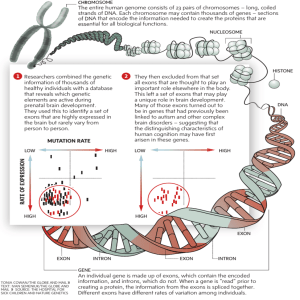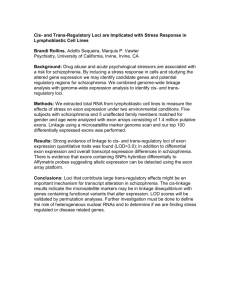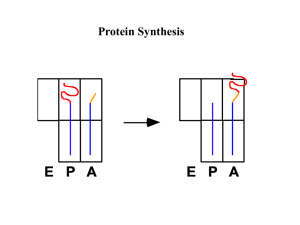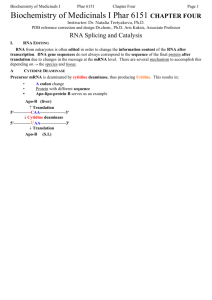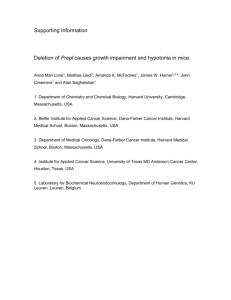Conservation of Exon Scrambling in Human ...
advertisement
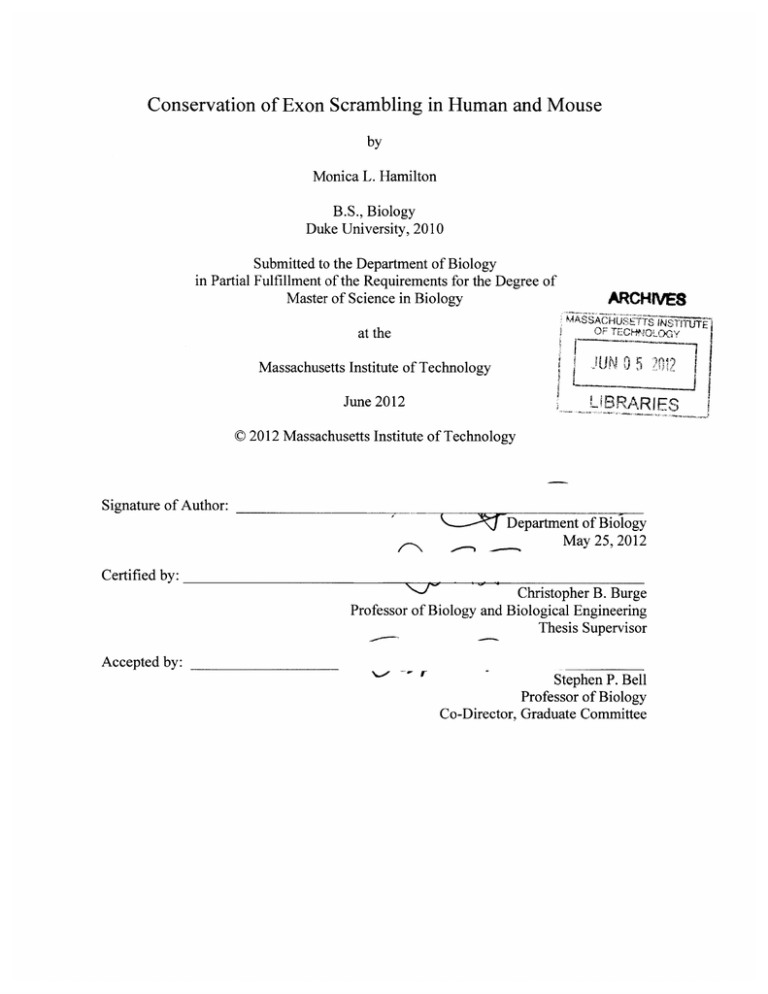
Conservation of Exon Scrambling in Human and Mouse
by
Monica L. Hamilton
B.S., Biology
Duke University, 2010
Submitted to the Department of Biology
in Partial Fulfillment of the Requirements for the Degree of
Master of Science in Biology
at the
ARCHIVES
OF
CHNOLG
1
50
Massachusetts Institute of Technology
L~~
June 2012
UBRA R IES
© 2012 Massachusetts Institute of Technology
Signature of Author:
K.- 2
Department of Biology
May 25, 2012
Certified by:
Christopher B. Burge
Professor of Biology and Biological Engineering
Thesis Supervisor
Accepted by:
1
-
rF
Stephen P. Bell
Professor of Biology
Co-Director, Graduate Committee
2
Conservation of Exon Scrambling in Human and Mouse
by
Monica L. Hamilton
Submitted to the Department of Biology
on May 25, 2012 in Partial Fulfillment of the
Requirements for the Degree of
Master of Science in Biology
ABSTRACT
Exon scrambling is a phenomenon in which the exons of an mRNA transcript are spliced
in an order inconsistent with that of the genome. In this thesis, I present a computational
analysis of scrambled exons in human and mouse. RNA-seq data was mapped to the
genome and all unaligned reads were subsequently mapped to a database of all possible
exon-exon junctions. Eight conserved genes were found to undergo scrambled splicing in
both species. In several cases, not only the gene was conserved, but the particular exons
involved were conserved as well. Reading frame was preserved in just over half of the
events, indicating that although some transcripts may be translated into protein, some
may be non-functional or may play a regulatory role. The introns flanking scrambled
exons were significantly longer than average, providing clues to the mechanism for this
abnormal splicing pattern. The results of this study demonstrate that presence of
scrambled transcripts in the cell is infrequent, but can be conserved over tens of millions
of years of evolution, suggesting it has a biological function.
Thesis Supervisor: Christopher B. Burge
Title: Professor
3
Acknowledgments
I would like to thank my advisor, Chris Burge, for both his scientific mentorship
and his support of my goals. I would also like to thank all of the members of the Burge
lab. I appreciate not only their willingness to answer questions and lend advice, but also
their camaraderie during this past year.
4
Table of Contents
A bstract ...............................................................................................
3
A cknow ledgm ents .................................................................................
4
Table of C ontents .................................................................................
5
Introduction ........................................................................................
6
M aterials and M ethods ............................................................................
11
Results ...............................................................................................
12
D iscussion .........................................................................................
16
Acknowledgments ...............................................................................
20
References .........................................................................................
21
F igures ..........................................................................................
T ables .............................................................................................
5
. . 24
. 36
Introduction
Splicing, the removal of introns and joining of exons to form a mature
transcript' 12, is a critical step in the processing of RNA in higher eukaryotes. Precise
excision of introns is crucial to an organism's viability; if a mutation occurs in a splice
site or other splicing regulatory sequence, it can lead to disease3 4 . In fact, it is thought
that between 50% and 60% of disease-causing mutations affect splicing5 . Additionally,
trans-acting mutations that disrupt the splicing machinery can have drastic consequences
on the health of an individual, such as myotonic dystrophy6 . For these reasons, splicing
must be heavily regulated.
The cellular machinery responsible for catalyzing this exact intron removal and
exon joining is the spliceosome, a large complex of RNA and protein 7'8 . The recognition
of exon-intron boundaries is aided by three sequences that are present in all introns from
yeast to humans: the 5' splice site, the 3' splice site, and the branch point sequence
(Figure 1). Additionally, metazoans possess a polypyrimidine tract upstream of the 3'
splice site that contributes to splicing. If splicing were a completely constitutive process,
these sequences might provide sufficient instructions for the cell; however, the situation
is more complex.
The average human gene contains 10.4 exons, yet the average mature transcript
contains only 9.1 exons9 . This discrepancy can be explained by the phenomenon of
alternative splicing (AS), in which the exons of a gene can be joined together in various
combinations. AS can be categorized into several classes (Figure 2)10-13. The most
prevalent type of AS is exon skipping (also known as a cassette exon), in which an exon
is not spliced into the mature transcript and is instead removed alongside its two flanking
6
introns. In the case of mutually exclusive exons, one of two neighboring exons is
included while the other is excluded; the exons can be neither both included nor both
excluded. In addition to events that include or exclude an entire exon, there are two types
of events that allow an exon to be partially skipped: alternative 5' splice sites and
alternative 3' splice sites. Finally, intron retention is the rarest type of alternative splicing,
in which an intron is included in the final transcript.
Alternative splicing enables organisms to diversify their expression without
increasing the size of their genomes. The Drosophilagene DSCAM, the poster child for
alternative splicing, has the potential to form more than 38,000 isoforms, due to mutually
exclusive splicing of its 95 exons' 4 "5 . This figure only considers the isoforms that can be
formed when splicing occurs in an order consistent with the genome. If genomic
sequence were not a constraint on splicing and instead exons were allowed to join in any
order, the number of potential isoforms that could be generated would be astronomical.
In fact, there are several known exceptions to this sequential splicing rule. One
such example is trans-splicing during which exons from two different RNA molecules
are spliced together to form a single mature transcript. This type of splicing was first
observed in trypanosomes. Trypanosome transcripts undergo SL (spliced leader) transsplicing in which one of the transcripts contains a common 39-base sequence (termed the
spliced leader) that is donated to the 5' of end of the other variable transcript16 . In this
way, every trypanosome transcript contains the same first exon. Later, many other
organisms from diverse phyla were found to exhibit SL trans-splicing including
euglenozoa, cnidarians, nematodes, platyhelminthes, and tunicates''".
7
Though SL trans-splicinghas not been observed in arthropods or vertebrates,
other forms of non-sequential splicing have been found. For example, the Drosophila
genes mod(mdg4)19,20 and lola2 1 exhibit trans-splicing between distinct RNA molecules.
In the case of the mod gene, exons from both the sense and antisense strands are
incorporated into a single transcript; with lola, the exons are all derived from the same
strand, but interallelic complementation studies have provided evidence that exons from
both copies of the gene are utilized. This mechanism differs significantly from SL transsplicing in which the donated exon is non-coding and therefore does not contribute to
protein functionality.
Finally, since the early 1990s, a phenomenon dubbed "exon scrambling" has been
observed at low frequency
. In exon scrambling, exons from a single gene are spliced
together using consensus splice sites, but in an order that differs from that of the genome.
This novel type of splicing was first described by Nigro and coworkers in the tumor
suppressor DCC . Two sets of exon junction-specific primers were designed, one for
each possible orientation of two putative neighboring exons, and both PCR products were
observed, with the non-genomic orientation present at 1 / 1 0 0 0 th the level of the genomic
orientation. Importantly, 90% of the scrambled transcripts showed no evidence of a
polyA tail, suggesting that the molecules were circular. Therefore, it was proposed that
such transcripts are likely mistakes in the normal splicing process, as opposed to a
meaningful biological phenomenon.
The first evidence for polyadenylation of transcripts came from Caldas et al. in
1998, demonstrating that not all scrambled transcripts are circular 2 6. Due to the presumed
linear nature of the transcripts, it seemed probable that exon scrambling may be the result
8
of trans-splicingof two different mRNA molecules. Polyadenylation of scrambled
transcripts has been upheld in a number of subsequent publications 2 8 ,2 9 ,3 3 ,35 ,4 0 . This debate
is far from over, however, with several other studies still providing support for circular
transcripts23-25,30
Another significant finding associated with exon scrambling was the observation
that the introns flanking the scrambled junctions tended to be especially long.
This
finding has been upheld by several other reports25,28,37,39 , perhaps offering some
mechanistic insight into the formation of these abnormal transcripts.
A different mechanistic explanation for exon scrambling was proposed by
Zaphiropoulos 24,25 . After observing a correlation between scrambled exons and their
reciprocal exon skipping events, it was suggested that exon scrambling and exon skipping
may in fact be interrelated. This interrelatedness was questioned, though, by Caldas et al.
in their study of the MLL gene 26 , in which no such correlation was seen. No further
evidence has been provided to support this reciprocal occurrence, though it would
certainly provide a reasonable explanation for the existence of the abnormal transcripts.
Of all the exon scrambling instances identified to date, only one corresponding
protein product has been catalogued2 7 . Through Western blotting, two isoforms of the rat
carnitine octanoyl-transferase (COT) protein were immunolocalized, one corresponding
to the normal protein and the other corresponding to a protein with exons two and three
repeated. Whether or not this protein is able to perform its normal function in the cell is
still a question to be answered. It will be interesting to see if this represents a unique
event or if other translated products can be found.
9
More recently, large-scale computational analyses have attempted to determine
the frequency of scrambled events 38-40 . While these studies may have a higher rate of
false positives due to their high throughput nature, they have been able to confirm some
overarching themes, such as proximity to large introns.
Scrambled exons have long held a controversial position in the field of splicing,
as to whether they represent a biologically significant variation or whether they are
simply a consequence of noise in the splicing process. In this thesis, I aim to establish
whether exon scrambling represents a meaningful splicing variation by examining
conservation of scrambled events between human and mouse.
10
Materials and Methods
TranscriptomeSequencing
Human RNA-seq data was obtained from the Illumina Human Body Map 2.0
Project, which is available in the ENA archive with accession number ERP000546
(http://www.ebi.ac.uk/ena/data/view/ERP000546). The Body Map 2.0 data were
generated by the Expression Applications R&D group at Illumina using a standard
polyA-selected Illumina RNA-Seq protocol from total RNA obtained commercially
(Ambion) using the HiSeq 2000 system. Reads were 50 bp in length.
Mouse RNA was collected from three individuals and in nine tissues: brain,
colon, heart, kidney, liver, lung, skeletal muscle, spleen, and testes. Paired-end RNAsequencing was performed using a standard polyA-selected on Illumina Hi-Seq. Reads
were sequenced to a length of 36, 40, 50, 75, or 80 bp. Only 36 and 50 bp reads were
used in this analysis, which were derived from two of the three mice.
Identificationof ScrambledEvents
Reads were aligned to the UCSC hg 19 and mm9 genomes using the Bowtie
aligner . Only the best mappings were reported with a maximum of two mismatches. All
reads that did not align to the genome were then aligned to the junction database using
Bowtie with the same parameters as above. The junction database was generated to
include all possible exon-exon junctions for each gene. Junctions were classified as
forward (an upstream exon followed by a downstream exon), reverse (a downstream exon
followed by an upstream exon), or same (the repetition of an exon).
11
Results
Human and mouse paired-end Illumina RNA sequencing reads were mapped to
their respective genomes using Bowtie. All reads that failed to align were then mapped to
a custom database of all permutations of exon-exon junctions, including exons whose
order was rearranged relative to the genome and repeated exons. Junctions were
considered scrambled if the 3' end of an exon was followed by the 5' end of a
genomically upstream exon or by the 5' end of the same exon. Reads that mapped to the
junction database were filtered to have at least 8 matching bases on each side of the exonexon boundary. Additionally, both reads of the pair must have mapped to the same
chromosome to be considered for analysis.
We found 6,975 reads mapping to scrambled junctions in mouse, representing
3,496 events and 1,916 genes. In human, we found 2,632 scrambled reads, with 626
events and 479 genes. As a quality filter, the analysis was limited to events that had at
least one library with at least two supporting reads, reducing these numbers substantially.
Out of the 14,773 genes that share orthology between mouse and human, 68 genes
showed evidence of scrambling in mouse, 178 genes showed evidence of scrambling in
human, and 11 genes show evidence of scrambling in both human and mouse. However,
after visual inspection and manual alignment of the reads to the genome using UCSC's
BLAT42, only eight of these appear to be valid exon scrambling events (Figures 4 - 11).
Using the hypergeometric test on these values yields a statistically significant p-value of
1.5 x 10-6.
One of the conserved scrambled genes is Aridla, an AT-rich interactive domaincontaining protein. For both human and mouse, a single supporting read is shown in
12
Figure 4. In each species, the first half of the read maps to the 3' end of the fourth exon of
Aridla, while the second half of the read maps to the 5' end of the second exon. BLAT
was used for validation of these mappings: each segment of the read yielded a single hit
corresponding to the location found in the junction database 43 . By visual inspection, it
appears as though the exons participating in the scrambled splicing (and not just the
genes) are orthologous; this was confirmed by look-up in a gene-oriented exon orthology
dataset by Fu et al.44 .
In addition to exons spliced out of order, we witnessed exons spliced to
themselves. For example, in Slc8al, a gene belonging to the sodium/calcium solute
carrier family, the first half of the read maps to the 5' end of the second exon and the
second half of the read maps to the 3' end of the same exon (Figure 5). Two possible
explanations can account for this read: trans-splicing has occurred between two
transcripts to yield a mature mRNA with a repeated second exon, or intra-transcript
splicing has yielded a circular transcript (Figure 3). Because libraries were prepared with
polyA selection, circular RNA molecules should be substantially under-represented in (or
absent from) the sequencing results.
As stated above, out of the eleven scrambled genes shared between human and
mouse, three appear to be false positives. One such case is obscurin (Obscn), a
cytoskeletal calmodulin and titin-interacting RhoGEF. Obscn is a very large protein
(about 800 kDa) present in striated muscle that is encoded by about 100 exons 45'4 6 . Most
of the exons contain immunoglobulin- and fibronectin-like domains and undergo a large
amount of alternative splicing. With such a highly expressed gene containing many
13
similar exons, it would not be surprising if some reads mapped to scrambled junctions
instead of the junctions they were truly derived from due to sequencing errors.
The two other highly suspect scrambled genes are Tpml and Abi3bp. In both
cases, the junction position is skewed toward the end in all supporting reads and there are
one or two mismatches in the shorter overhang. It is difficult to estimate the number of
false positives without manually examining the supporting reads for each potential exon
scrambling event. One way to approximate this error rate is to look at the overall
distribution of where in the read the junction falls. The more bases that accurately map to
each side of the junction, the more likely the read represents a true exon scrambling
event. Theoretically, the position of a junction within a read should be uniformly
distributed. However, in the case of mouse, there is a large peak of junctions towards one
end of the read (Figure 12). When reads are binned by number of mismatches, this peak
is especially pronounced with two mismatches (the maximum number of mismatches
allowed by the filter). This peak likely corresponds to a high level of false positives due
to the less stringent criteria: two mismatches and just ten bases of overhang.
The exon-specific orthology analysis described for Aridla was performed on all
eight conserved genes (Table 1). In four of the genes (Aridla, Rsfl, Slc8al, and
Manla2), both exons involved in scrambling were orthologous between mouse and
human. In three genes (Stm3, Zc3h6, and Anp32b), only one of the two exons was
orthologous, and in one gene (App), neither exon was orthologous. Those genes that
conserved the exon-exon junction are more likely to represent functional products than
those for which just the gene is conserved.
14
Several previous studies had indicated that exon scrambling was often found next
to large introns23,25,30,38,47. This appears to be consistent with the eight conserved
scrambled genes as well. The intron upstream of the acceptor splice site had a mean
length of 27,553 bp in mouse and 31,021 bp in human while the intron downstream of the
donor splice site had a mean of 32,713 bp in mouse and 42,873 bp in human (Table 1).
According to a z-test, these lengths are significantly greater than the overall mean intron
length, documented at 2,874 bp in mouse and 3,749 bp in human4 8. This tendency
towards longer introns flanking scrambled exons may be indicative of an underlying
mechanism for exon scrambling.
In order to evaluate whether the eight conserved scrambled events have any
functional consequences in the cell, each event was tested for preservation of reading
frame. Reading frame was considered preserved if the reading frame of the scrambled 3'
exon was the same as that of the normal 3' exon; for example, in a scrambling event in
which exon 5 is followed by exon 2, the reading frames of exon 6 and exon 2 would be
compared. In all, ten out of the sixteen events (mouse and human counted separately)
exhibited reading frame preservation. Those events that introduced frame shifts would
most likely produce mRNAs that would be degraded by the nonsense-mediated mRNA
decay pathway. This may imply that the scrambled events have no functional role in the
cell since they are unlikely to form stable protein. Alternatively, this may suggest a gene
regulatory role for the exon scrambling.
15
Discussion
The splicing of non-sequential exons is not a novel concept in biology. Trans-
splicing was demonstrated in vitro in 198547'48. It also occurs ubiquitously in
trypanosomes and other organisms in which a common spliced leader exon is spliced to
the beginning of every transcript' 6. More recently, it has become clear that trans-splicing
can occur between two transcripts of the same gene (homotypic trans-splicing), as
opposed to between transcripts of different genes (heterotypic trans-splicing).
Exon scrambling, in which exons of the same gene are spliced in an order
inconsistent with the genome, has been described in a number of higher eukaryotic
species. The origin of these shuffled transcripts has been a matter of debate for some
time. Two plausible explanations have been offered: a scrambled junction may represent
a circular RNA molecule that is the by-product of the normal splicing process
,30 or it
may be the product of splicing between two transcripts of the same gene 26,28,29,33,3,40
(Figure 3). In this study, because polyadenylation selection was performed during library
preparation, it is likely that the scrambled transcripts were derived from trans-splicing.
One limitation faced was the overall low number of scrambled reads, which made
applying meaningful filters a challenge. Only events for which at least two supporting
reads were found in the same library were considered for this study. Ideally a more
stringent filter would have been applied, perhaps requiring multiple libraries or a larger
number of reads per event, but due to the rarity of exon scrambling this was not possible.
Additionally, since the reads were not barcoded, it was not possible to determine if
identical reads were an artifact of PCR amplification of the same original mRNA
fragment or if they represented unique events.
16
Another difficulty in using computational methods to identify potentially
scrambled transcripts is the high level of false positives. The suspiciously large number
of reads with a short overhang and two mismatches indicates that these may represent
mis-mappings of normal exon-exon junctions rather than truly scrambled junctions
(Figure 12). As with other computationally-based studies40, manual curation was used to
screen all putative conserved events for repetitive or suboptimal matches.
Consistent with several other reports23,25,28,37,39, it was observed that exons
involved in scrambling are adjacent to longer-than-average introns. This may possibly
have a mechanistic basis. Splicing generally occurs co-transcriptionally, such that by the
time transcription is finished, the pre-mRNA molecule has been processed into a mature
transcript 9' 50. However, if an exceptionally large intron is being transcribed, then there
may be a substantial period during which a 5' donor splice site is waiting to be spliced.
The longer the intron, the more likely it may be that the free donor site will be spliced to
another nearby nascent transcript. In fact, this hypothesis has been experimentally tested
by Takahara et al.37. By inserting various sequences to pause the trajectory of RNAPII,
they demonstrated that delay of 3' splice site transcription increases the frequency of
trans-splicing.
In order to analyze whether exon scrambling may have functional consequences
in the cell, putative scrambling events were tested for reading frame conservation.
Although 6 of 16 events did not preserve reading frame and thus are likely subject to
nonsense-mediated decay (NMD) 5 1-53 , these transcripts may still play a regulatory role.
By splicing together exons that result in a frameshift mutation, the effective amount of
protein synthesized is decreased while maintaining the same level of transcription.
17
Of the eight scrambled genes that share orthology between human and mouse, one
was also identified as a top hit in a separate large-scale search for scrambled exons41. As
in this study, the authors found Manla2 to have many supporting reads and to occur in
multiple samples. Additionally, of the three scrambled exon pairs reported in Manla2,
one pair (exon 5 joined to exon 2) matched the junction conserved by human and mouse
in this study (Figure 6). Furthermore, in their experimental test for conservation in
mouse, the Manla2 5-2 PCR product was observed in all tissues analyzed. Finally, a
quantitative PCR analysis showed that the 5-2 scrambled transcript was present at levels
on par with the normal 5-6 junction. With such strong evidence in support of this event, it
is tempting to speculate that it is translated into a functional protein product. This is
certainly plausible, as the scrambled event preserves the normal reading frame. Because
the protein has not yet been crystallized, it is difficult to predict what effect the repetition
of exons 2, 3, 4, and 5 would have on the protein's structure and activity; nevertheless, it
is the most promising example of scrambling with functionality.
Finally, the fact that there is such limited overlap between the eight conserved,
manually curated scrambled genes from this study and the experimentally validated genes
of other studies suggests that that there are still many more events to be documented.
Clearly the screen for exon scrambling has not been saturated and it will require more
data and more analysis before we have a complete understanding of the full extent of
exon scrambling.
Whether referred to as trans-splicing27,31,33,37, exon repetition 28,29,34,36, post-
transcriptional exon shuffling 40 , rearrangements or repetition in exon order (RREO) 39, or
exon scrambling 2 2 ,26 ,32 , transcripts with unordered exons still hold a controversial position
18
in the field of splicing. While this study has helped to identify several scrambled genes
conserved between mouse and human, it is still unclear what role these transcripts may
play in the cell. Though it is uncertain if they represent intentional splicing variations or
simply noise in the cell's splicing machinery, the conservation of some of these events
for the tens of millions of years separating human from mouse suggests that some exon
scrambling play a biologically important role.
19
Acknowledgments
We thank Jason Merkin for his work in generating the mouse RNA-seq data sets
and Alex Robertson for his analysis of the human data.
20
References
1. Berget, S. M., Moore, C.& Sharp, P. A. Spliced segments at the 5' terminus of
adenovirus 2 late mRNA. Proc.Natl.A cad. Sci. U.S.A. 74, 3171-3175 (1977).
2. Chow, L. T., Gelinas, R. E., Broker, T. R. & Roberts, R. J.An amazing sequence
arrangement at the 5' ends of adenovirus 2 messenger RNA. Cell 12, 1-8 (1977).
3. Cartegni, L., Chew, S. L. & Krainer, A. R. Listening to silence and understanding
nonsense: exonic mutations that affect splicing. Nature Reviews Genetics 3, 285-298
(2002).
4. Evsyukova, I.,Somarelli, J.A., Gregory, S. G.& Garcia-Blanco, M.A. Alternative
splicing in multiple sclerosis and other autoimmune diseases. RNA Biol 7, 462-473
(2010).
5. Wang, G.-S. & Cooper, T. A. Splicing in disease: disruption of the splicing code and
the decoding machinery. Nature Reviews Genetics 8, 749-761 (2007).
6. Sicot, G., Gourdon, G.& Gomes-Pereira, M. Myotonic dystrophy, when simple repeats
reveal complex pathogenic entities: new findings and future challenges. Human
MolecularGenetics 20, R116-R123 (2011).
7. Wahl, M. C., Will, C.L. & Ltihrmann, R. The Spliceosome: Design Principles of a
Dynamic RNP Machine. Cell 136, 701-718 (2009).
8. Will, C.L. & Liihrmann, R. Spliceosome Structure and Function. Cold Spring Harb
PerspectBiol 3, (2011).
9. International Human Genome Sequencing Consortium. Finishing the euchromatic
sequence of the human genome. Nature 431, 931-945 (2004).
10.
Matlin, A. J., Clark, F. & Smith, C.W. J.Understanding alternative splicing:
towards a cellular code. Nature Reviews MolecularCell Biology 6, 386-398 (2005).
11.
Sammeth, M., Foissac, S. & Guig6, R. A General Definition and Nomenclature
for Alternative Splicing Events. PLoS Comput Biol 4, (2008).
12.
Wang, Z. & Burge, C.B. Splicing Regulation: From a Parts List of Regulatory
Elements to an Integrated Splicing Code. RNA 14, 802-813 (2008).
13.
Keren, H., Lev-Maor, G.&Ast, G.Alternative splicing and evolution:
diversification, exon definition and function. Nature Reviews Genetics 11, 345-355
(2010).
14.
Schmucker, D. et al. Drosophila Dscam is an axon guidance receptor
exhibiting extraordinary molecular diversity. Cell 101, 671-684 (2000).
15.
Graveley, B. R. Mutually Exclusive Splicing of the Insect Dscam Pre-mRNA
Directed by Competing Intronic RNA Secondary Structures. Cell 123, 65-73 (2005).
16.
Van der Ploeg, L. H. Discontinuous transcription and splicing in
trypanosomes. Cell 47, 479-480 (1986).
17.
Hastings, K. E. M. SL trans-splicing: easy come or easy go? Trends in Genetics
21, 240-247 (2005).
18.
Pettitt, J., Harrison, N., Stansfield, I.,Connolly, B. & Mdller, B. The evolution of
spliced leader trans-splicing in nematodes. Biochem. Soc. Trans. 38, 1125-1130
(2010).
19.
Dorn, R., Reuter, G.& Loewendorf, A. Transgene analysis proves mRNA transsplicing at the complex mod(mdg4) locus in Drosophila. Proc.Natl.A cad. Sci. U.S.A.
98, 9724-9729 (2001).
21
20.
Labrador, M.et al. Protein encoding by both DNA strands. Nature 409, 1000
(2001).
Horiuchi, T., Giniger, E. & Aigaki, T. Alternative trans-splicing of constant and
21.
variable exons of a Drosophila axon guidance gene, lola. Genes Dev. 17, 2496-2501
(2003).
Nigro, J.M. et al. Scrambled exons. Cell 64, 607-613 (1991).
22.
23.
Cocquerelle, C., Daubersies, P., Majerus, M.A., Kerckaert, J. P. & Bailleul, B.
Splicing with inverted order of exons occurs proximal to large introns. EMBOJ. 11,
1095-1098 (1992).
24.
Zaphiropoulos, P. G. Circular RNAs from transcripts of the rat cytochrome
P450 2C24 gene: correlation with exon skipping. Proc.Nat. Acad. Sc. U.S.A. 93,
6536-6541 (1996).
Zaphiropoulos, P. G. Exon skipping and circular RNA formation in transcripts
25.
of the human cytochrome P-450 2C18 gene in epidermis and of the rat androgen
binding protein gene in testis. Mol. Cell. Biol. 17, 2985-2993 (1997).
Caldas, C.et al. Exon scrambling of MLL transcripts occur commonly and
26.
mimic partial genomic duplication of the gene. Gene 208, 167-176 (1998).
Caudevilla, C.et al. Natural Trans-Splicing in Carnitine Octanoyltransferase
27.
Pre-mRNAs in Rat Liver. PNAS 95, 12185-12190 (1998).
Frantz, S.A. et al. Exon Repetition in mRNA. PNAS 96, 5400-5405 (1999).
28.
Finta, C.& Zaphiropoulos, P. G.The Human CYP2C Locus: A Prototype for
29.
Intergenic and Exon Repetition Splicing Events. Genomics 63, 433-438 (2000).
Surono, A. et al. Circular Dystrophin RNAs Consisting of Exons That Were
30.
Skipped by Alternative Splicing. Hum. Mol. Genet. 8, 493-500 (1999).
Akopian, A. N. et al. Trans-splicing of a voltage-gated sodium channel is
31.
regulated by nerve growth factor. FEBS Letters 445, 177-182 (1999).
Crawford, J.et al.ThePISSLREGene: Structure, Exon Skipping, and Exclusion
32.
as Tumor Suppressor in Breast Cancer. Genomics 56, 90-97 (1999).
Takahara, T., Kanazu, S.-I., Yanagisawa, S. &Akanuma, H. Heterogeneous Sp1
33.
mRNAs in Human HepG2 Cells Include a Product of Homotypic Trans-Splicing.j.
Biol. Chem. 275, 38067-38072 (2000).
Hide, W. A., Babenko, V. N., Van Heusden, P. A., Seoighe, C.& Kelso, J.F. The
34.
Contribution of Exon-Skipping Events on Chromosome 22 to Protein Coding
Diversity. Genome Res. 11, 1848-1853 (2001).
Flouriot, G., Brand, H., Seraphin, B. & Gannon, F. Natural Trans-Spliced
35.
mRNAs Are Generated from the Human Estrogen Receptor-A (hERx) Gene. J. Biol.
Chem. 277, 26244-26251 (2002).
Rigatti, R., Jia, J.-H., Samani, N. J.& Eperon, I.C.Exon Repetition: A Major
36.
Pathway for Processing mRNA of Some Genes Is Allele-Specific. Nucl. Acids Res. 32,
441-446 (2004).
Takahara, T., Tasic, B., Maniatis, T., Akanuma, H. &Yanagisawa, S. Delay in
37.
Synthesis of the 3' Splice Site Promotes trans-Splicing of the Preceding 5' Splice Site.
Molecular Cell 18, 245-251 (2005).
Shao, X., Shepelev, V. & Fedorov, A. Bioinformatic Analysis of Exon Repetition,
38.
Exon Scrambling and Trans-Splicing in Humans. Bioinformatics22, 692-698 (2006).
22
39.
Dixon, R. J., Eperon, I. C., Hall, L. & Samani, N. J.A Genome-Wide Survey
Demonstrates Widespread Non-Linear mRNA in Expressed Sequences from Multiple
Species. Nucl. Acids Res. 33, 5904-5913 (2005).
40.
Al-Balool, H. H. et al. Post-Transcriptional Exon Shuffling Events in Humans
Can Be Evolutionarily Conserved and Abundant. Genome Res. 21, 1788-1799
(2011).
41.
Langmead, B., Trapnell, C., Pop, M. & Salzberg, S. L. Ultrafast and memoryefficient alignment of short DNA sequences to the human genome. Genome Biology
10, R25 (2009).
42.
Kent, W. J.BLAT-The BLAST-Like Alignment Tool. Genome Res. 12, 656-664
(2002).
43.
Fu, G.C.-L. & Lin, W. Identification of gene-oriented exon orthology between
human and mouse. BMC Genomics 13, S10 (2012).
44.
Fukuzawa, A., Idowu, S. & Gautel, M. Complete human gene structure of
obscurin: implications for isoform generation by differential splicing.Journalof
Muscle Research and Cell Motility 26, 427-434 (2005).
45.
Kontrogianni-Konstantopoulos, A., Ackermann, M.A., Bowman, A. L., Yap, S.V.
& Bloch, R. J. Muscle Giants: Molecular Scaffolds in Sarcomerogenesis. PhysiolRev
89, 1217-1267 (2009).
46.
Hong, X., Scofield, D. G. & Lynch, M. Intron Size, Abundance, and Distribution
Within Untranslated Regions of Genes. Mol Biol Evol 23, 2392-2404 (2006).
47.
Konarska, M. M., Padgett, R. A. & Sharp, P. A. Trans splicing of mRNA
precursors in vitro. Cell 42, 165-171 (1985).
48.
Solnick, D. Trans splicing of mRNA precursors. Cell 42, 157-164 (1985).
49.
Reed, R. Coupling transcription, splicing and mRNA export. CurrentOpinion in
Cell Biology 15, 326-33 1 (2003).
50.
Han, J., Xiong, J., Wang, D. & Fu, X.-D. Pre-mRNA splicing: where and when in
the nucleus. Trends in Cell Biology 21, 336-343 (2011).
51.
McGlincy, N. J.& Smith, C.W. J.Alternative splicing resulting in nonsensemediated mRNA decay: what is the meaning of nonsense? Trends in Biochemical
Sciences 33, 385-393 (2008).
52.
Rebbapragada, I. & Lykke-Andersen, J.Execution of nonsense-mediated
mRNA decay: what defines a substrate? CurrentOpinion in Cell Biology 21, 394-402
(2009).
53.
Nicholson, P. & Mifhlemann, 0. Cutting the nonsense: the degradation of PTCcontaining mRNAs. BiochemicalSociety Transactions38, 1615 (2010).
23
Figure 1
Figure 1. Canonical splicing.
There are three core splicing signals present in all introns: the 5' splice site (GU), the
branch point (A) and the 3' splice site (AG). Additionally, a polypyrimidine tract located
between the branch point and the 3' splice site aids in splice site recognition in higher
eukaryotes.
24
Figure 2
a.
L
2
Figure 2. Alternative splicing falls into five categories:
a. Exon skipping, the most prevalent form of alter native splicing results in the
exclusion of an exon from the mature transcript.
b. Alternative 5' splice sites allow exclusion of just a terminal portion of an exon.
c. Alternative 3' splice sites regulate the inclusion or exclusion of the initial segment
of an exon.
d. Mutually exclusive exons allow either one or the other (but not both or neither) of
two neighboring exons to be included in the mature mRNA.
e. Intron retention causes an intronic sequence to be expressed in the final transcript.
25
Figure 3
a.
b.
C.
MINH_
1
2
3
E-U
4
Fig ure 3. Exon scrambling.
a. A read maps across a scrambled junction from exon 3 to exon 2.
b. There are two possible splicing events that can explain the read: two separate premRNAs are trans-spliced(left) or a single pre-mRNA is spliced in the reverse
junction (right).
c. There are two possible mature mRNAs from which the read could have been
derived: a longer transcript with exons 2 and 3 appearing in tandem duplication
(left) or a circular read (right).
26
Figure 4
Aridla
5'
GTCAA3G-
T7 A3TTGC T TCATCA T
133,278,966
133,275,452
MOUSE
AAGGCCTCCAGCTTGCT
Chr. IV
I
hF
I
3'
-AATGGATCAGATGGGAA
I
i
W
HUMAN
ACQT
cC
GTAGCCCGCJCT
t
27,056,142
5'
27,059,283
GTCAAGACCCTCCAGCTTGCCT
ICCATCCAGTCCAATGGATCAGATGGGCA3'
Figure 4. Arid la, AT rich interactive domain 1A
One of the eight conserved genes exhibiting exon scrambling is Aridla. In both mouse
(top) and human (bottom), the first half of the read maps to the 3' end of exon four and
the second half of the read maps to the 5' end of exon two. Both exons involved are
conserved (indicated by the double green lines). Neither read contains a mismatch and the
exon-exon junctions falls fairly close to the middle, thus increasing our confidence in this
event.
27
Figure 5
Sic8al
5'
TGGAGAGCTCGAATTCCAGAACGATGAA~ATA3T|
GT P
T
9A9I3AAG
3'
82,047,149
82,048,978
MOUSE
7--
Chr. XVi
Chr. I
I 'm
I
Ii
t
t40,657,441
5'
TTCCAGAATGATGAAATTGT|
40,655,613
TTTACAGTTO5AAGPCAT;TA AA
3'
Figure 5. Slc8al, Solute carrier family 8 (sodium/calcium exchanger) member 1
One of the eight conserved genes exhibiting exon scrambling is Slc8al. In both mouse
(top) and human (bottom), the first half of the read maps to the 3' end of exon two and the
second half of the read maps to the 5' end of the same exon two. Exon two is orthologous
between human and mouse (indicated by the double green lines).
28
Figure 6
Manla2
5'
A
T T
GAAGAAGAAGA
100,460,197
3AGGAGAGGAAT
TCTGAGAAATAAGATTAG
3'
100,448,464
MOUSE
Chr. III
Chr. I
HUMAN
5'
ATTACCTATCAGGAGAGGAGGGAAGAGGAAGAACGTCTGAGAAATAAAAT
3'
Figure 6. Manla2, Mannosidase alpha, class lA, member 2
One of the eight conserved genes exhibiting exon scrambling is Manla2. In both mouse
(top) and human (bottom), the first half of the read maps to the 3' end of exon five and
the second half of the read maps to the 5' end of exon two. Both exons involved are
orthologous between mouse and human (indicated by the double green lines).
29
Figure 7
Anp32b
,GAT7,9ATGAGGAT62AG T
,8
3'
46,484,339
46,472,962
MOUSE
Chr. IV
Chr. IX
HUMAN
100,773,553
5'
TGAAGATGAGGATGAGGACGAAG| AA4~AUAAKATGA
100,774,754
3AA3AcXA/GA'G 3'
Figure 7. Anp32b, Acidic (leucine-rich) nuclear phosphoprotein 32 family, member B
One of the eight conserved genes exhibiting exon scrambling is Anp32b. Only one half of
the scrambled exon-exon junction is conserved between mouse and human (indicated by
the double green line). In both mouse (top) and human (bottom), the first half of the read
maps to the 3' end of exon six; however, the second half of the mouse read maps to the 5'
end of exon two, whereas the second half of the human read maps to the 5' end of exon
five.
30
Figure 8
Rsf1
5'
AGTGTZ3GCT TCCGAACCAToCAGAACTA I AAGCATCAAAAGAAAATGAAA
104,809,323
MOUSE
3'
104,813,276
~ATGC
T IC~AAT Tr
GAA':A -C --A 1AA CTA
Chr. VII
Chr. XI
HUMAN
L..
-...
5'
...... J
.T.AcATCmcaT
AG.CT.
GGCAAACCATCCTGAGCTA|I AGGAACAGAAAGJAAAGTGAAAAGATGAAAAG
3'
Figure 8. Rsfl, Remodeling and spacing factor 1
One of the eight conserved genes exhibiting exon scrambling is Rsfl. In both mouse (top)
and human (bottom), the first half of the read maps to the 3' end of exon seven and the
second half of the read maps to the 5' end of exon six. Both exons involved are conserved
(indicated by the double green lines).
31
Figure 9
App
85,025,098
85,025,742
4
4
MOUSE
Chr. XVI
Chr. XXI
1
TGGTGAAGT
HUMAN
CCTT2
GTCGTGGAAGGTGTTTCGAG
2 7 ,3 9 4 , 1 56
27,425,664
5'
GTCTGTGGAA A,
TGGTTCGA
TT
TTT TAAs3TAT
TT
3'
Figure 9. App, Amyloid beta (A4) precursor protein
One of the eight conserved genes exhibiting exon scrambling is App. Neither half of the
scrambled exon-exon junction shares orthology between mouse and human. In mouse
(top), the first half of the read maps to the 3' end of exon eleven and the second half of
the read maps to the 5' end of exon ten; in human (bottom), the first half of the read maps
to the 3' end of exon six and the second half of the read maps to the 5' end of exon four.
32
Figure 10
Strn3
5'
-TACAGAATGol
I @CAC,;GATTQCATTTTTACAAGGAGA
TTTAGG3J AT
52,762,700
3'
52,748,981
~GTCAGGGTGTACG~GG
MOUSE
Chr. X11
U
Chr. XIV
-t
HUMAN
AAG
G GSAAG-GTG~A
t
t
31,398,407
31,425,448
5'
GGGTAGAAAGGGGTGAAGA
W"
GCCJCGGATTGCGTTTCTACAAGGCGAAAGA
3'
Figure 10. Strn3, Striatin, calmodulin binding protein 3
One of the eight conserved genes exhibiting exon scrambling is Strn3. Only one half of
the scrambled exon-exon junction is conserved between mouse and human (indicated by
the double green line). In both mouse (top) and human (bottom), the second half of the
read maps to the 5' end of exon two; however, the first half of the mouse read maps to the
3' end of exon seven, whereas the second half of the human read maps to the 3' end of
exon eight.
33
Figure 11
Zc3h6
128,823,608
128,816,827
MOUSE
Chr. I
Chr. 1I
HUMAN
5 5'
PAGA~
AAAGGA
A
G
AT
AA~T
TAA~
1,
A3
Figure 11. Zc3h6, Zinc finger CCCH type containing 6
One of the eight conserved genes exhibiting exon scrambling is Zc3h6. Only one half of
the scrambled exon-exon junction is conserved between mouse and human (indicated by
the double green line). In both mouse (top) and human (bottom), the second half of the
read maps to the 5' end of exon two; however, the first half of the mouse read maps to the
3' end of exon four, whereas the second half of the human read maps to the 3' end of exon
two.
34
Figure 12
800
_
T
-
700
-
0
mismatches
1 mismatches
2 mismatches
600
500
400 300
200100
B.0
0.2
0.4
0.6
0.8
junction position as fraction of read length
1.0
Figure 12. Estimating false positives.
In order to estimate the number of false positives in our putative scrambled exon set, the
junction positions were plotted to see where they fell along the reads. Reads were binned
by number of mismatches (two mismatches was the maximum allowed). A particularly
high peak can be seen at about 80% of the read length in the two mismatches bin (red).
This peak probably consists of false positives since the occurrence of two mismatches in
ten bases of overhang is likely to be the result of a mis-mapping.
35
......
..
..
...
....
Table 1
Name
Aridla
Rsf1
SIc8a1
Manla2
Strn3
Zc3h6
App
Anp32b
Chr +/ID
4 ENSMUSGOOOOO007880
7 +
ENSMUSGO0000035623
MOUSE
5' site
Intron
Intron
29418
23381
133275452
7606
5003
104813276
82047149 202216
11943
88671
28287
52748981
4780
29709
28823608
4270
23255
ENSMUSGO0000054640
ENSMUSGO0000008763
17 3 -
100448464
ENSMUSGOOO0020954
12 -
ENSMUSGO0000042851
2 +
ENSMUSGO0000022892
ENSMUSG00000028333
16 4 +
85025098
46484339
9493
620
4735
8741
RF ID
133278966 Y ENSGO0000117713
104809323 Y ENSG00000048649
82048978 Y ENSG00000183023
100460197 Y ENSG00000198162
3' site
52762700 N
128816827 N
85025742 Y
46472962 N
ENSG00000196792
ENSG00000188177
ENSG00000142192
ENSG00000136938
Chr +/1 +
HUMAN
5' site
27059283
77409532
40655613
11 2 1 +
14 -
117963271
31398407
2 +
113057606
21
-
9 +
27394156
100774754
Intron
Intron
3' site
RF
28064 32111
4876 23050
250618 23104
21582 33701
10095 69662
27056142 Y
77413540 N
40657441 N
117944806 Y
31425448 N
3200 23823
113057426 Y
27425664 Y
100773553 Y
36595
6118
2892
21659
Table 1. Conserved scrambled genes.
Genes with exon scrambling events that passed the filters in both mouse and human are listed above. The first column lists the gene
name. Next is listed the ENSEMBL gene ID. Following this are the junction position identifiers: chromosome number, strand, 5'
splice site genomic coordinate, length of intron downstream of 5' splice site, length of intron upstream of 3' splice site, and 3' splice
site genomic coordinate. The last column tells whether the reading frame has been preserved between the normal downstream junction
and the scrambled upstream junction ('Y' = preserved, 'N' = not preserved). Orthology of exons between human and mouse is
indicated by boldface type. For example, for the gene Anp32b, only the 5' exon involved in each scrambling event is orthologous.

